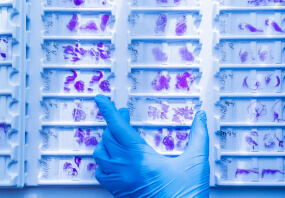General description
Alpha-synuclein (UniProt: P37840; also known as Non-A beta component of AD amyloid, Non-A4 component of amyloid precursor, NACP) is encoded by the SNCA (also known as NACP; PARK1) gene (Gene ID: 6622) in human. α-synuclein is abundantly expressed in the brain and is found in a classic amyloid fibril form within the intra-neuronal Lewy body deposits of Parkinson′s disease brains. In its monomeric form it participates in synaptic vesicle exocytosis by enhancing vesicle priming, fusion and dilation of exocytotic fusion pores. It acts by increasing local calcium release from microdomains, which is essential for the enhancement of ATP-induced exocytosis. In its multimeric form it acts as a molecular chaperone assisting in the folding of synaptic fusion components called SNAREs at presynaptic membrane. It is also shown to regulate dopamine release and transport. It reduces neuronal responsiveness to various apoptotic stimuli, leading to a decreased caspase-3 activation. Post-translationally it can be phosphorylated, predominantly on serine residues. Phosphorylation of serine 129 is reported to be selective and extensive in synucleinopathy lesions. In addition, increased phosphorylation of Tyr125, nitration of Tyr39, and glycation of α-synuclein have been reported in Parkinsons disease subjects. Nitration of tyrosine residues in α-synuclein is observed in the signature inclusions of Parkinsons disease, dementia with Lewy bodies, the Lewy body variant of Alzheimer s disease, and multiple system atrophy brains. EAAC1 -/- mice display age-dependent loss of dopaminergic neurons in the substantia nigra pars compacta and this neuronal loss is accompanied by increased nitrosylated α-synuclein and microglial activation. Genetic alterations of SNCA gene are reported to result in aberrant polymerization into fibrils, which is associated with several neurodegenerative diseases (synucleinopathies). (Ref.: Miranda, HV., et al. (2017). Sci. Rep. 7; 13713; Berman, AE., et al. (2011). Ann. Neurol. 69(3); 509 520; Giasson, BI., et al. (2000). Science. 290(5493); 985-989).
Specificity
Clone nSyn14 is a mouse monoclonal antibody that detects a/b synuclein nitrated at tyrosine 39.
Immunogen
Full-length recombinant human α-synuclein nitrated at tyrosine 39.
Application
Anti-nitro-α/β-Synuclein (Tyr39), clone nSyn14, Cat. No. 36-012-I, is a mouse monoclonal antibody that detects α/β-Synuclein nitrated on tyrosine 39 and is tested for use in ELISA, Immunohistochemistry, and Western Blotting.
Isotype testing: Identity Confirmation by Isotyping Test.
Isotyping Analysis: The identity of this monoclonal antibody is confirmed by isotyping test to be mouse IgG1.
Tested Applications
ELISA Analysis: A representative lot detected nitro- α/β-Synuclein (Tyr39) in ELISA applications (Giasson, B.I., et al. (2000). Science. 290(5493):985-9).
Immunohistochemistry Analysis: A representative lot detected nitro- α/β-Synuclein (Tyr39) in Immunohistochemistry applications (Maki, R.A., et al. (2019). Free Radic Biol Med. 141:115-140; Giasson, B.I., et al. (2000). Science. 290(5493):985-9).
Western Blotting Analysis: A 1:500 dilution from a representative lot detected nitro- α/β-Synuclein in Various a-synuclein protein samples (chemically nitrated or untreated) (Courtesy of Sarah Wright, Nitrome Biosciences, Inc., Brisbane, CA USA).
ELISA Analysis: Various dilutions of this antibody detected nitro- α/β-Synuclein in various a-synuclein protein samples (chemically nitrated or untreated) (Courtesy of Sarah Wright, Nitrome Biosciences, Inc., Brisbane, CA USA). .
Western Blotting Analysis: A representative lot detected nitro- α/β-Synuclein (Tyr39) in Western Blotting applications (Miranda, H.V., et al. (2017). Sci Rep. 7(1):13713; Fernandez, E., et al. (2014). Antioxid Redox Signal. 21(15):2143-8; Hung, L.W., et al. (2012). J Exp Med. 209(4):837-54; Giasson, B.I., et al. (2000). Science. 290(5493):985-9).
Note: Actual optimal working dilutions must be determined by end user as specimens, and experimental conditions may vary with the end user
Physical form
Purified mouse monoclonal antibody IgG1 in buffer containing 0.1 M Tris-Glycine (pH 7.4), 150 mM NaCl with 0.05% sodium azide.
Storage and Stability
Recommend storage at +2°C to +8°C. For long term storage antibodies can be kept at -20°C. Avoid repeated freeze-thaws.
Other Notes
Concentration: Please refer to the Certificate of Analysis for the lot-specific concentration.
Disclaimer
Unless otherwise stated in our catalog or other company documentation accompanying the product(s), our products are intended for research use only and are not to be used for any other purpose, which includes but is not limited to, unauthorized commercial uses, in vitro diagnostic uses, ex vivo or in vivo therapeutic uses or any type of consumption or application to humans or animals.
biological source: mouse. Quality Level: 200. conjugate: unconjugated. antibody form: purified antibody. antibody product type: primary antibodies. clone: nSyn14, monoclonal. mol wt: calculated mol wt 14.46 . kDa. purified by: using protein G. species reactivity: human, mouse. packaging: antibody small pack of 100 . μ. L. technique(s): ELISA: suitable, immunohistochemistry (formalin-fixed, paraffin-embedded sections): suitable, western blot: suitable. isotype: IgG1κ. . epitope sequence: N-terminal half. Protein ID accession no.: NP_000336. UniProt accession no.: P37840. shipped in: ambient. target post-translational modification: mutation (Tyr39). Gene Information: human ... SCNA(6622). Storage Class Code: 12 - Non Combustible Liquids. WGK: WGK 1. Flash Point(F): Not applicable. Flash Point(C): Not applicable.- UPC:
- 51172419
- Condition:
- New
- Availability:
- 3-5 Days
- Weight:
- 1.00 Ounces
- HazmatClass:
- No
- MPN:
- 36-012-I-100UL












